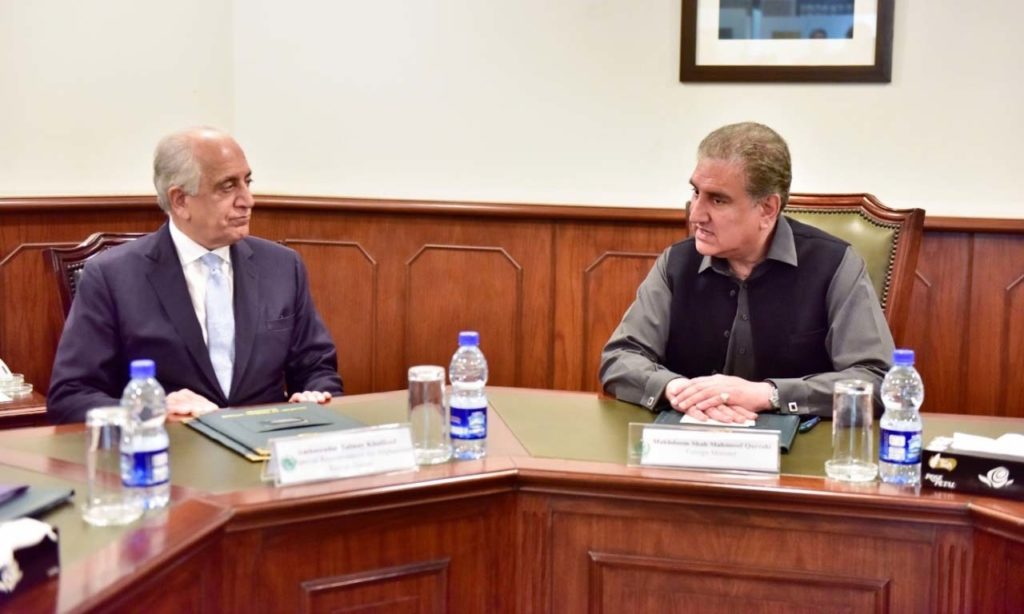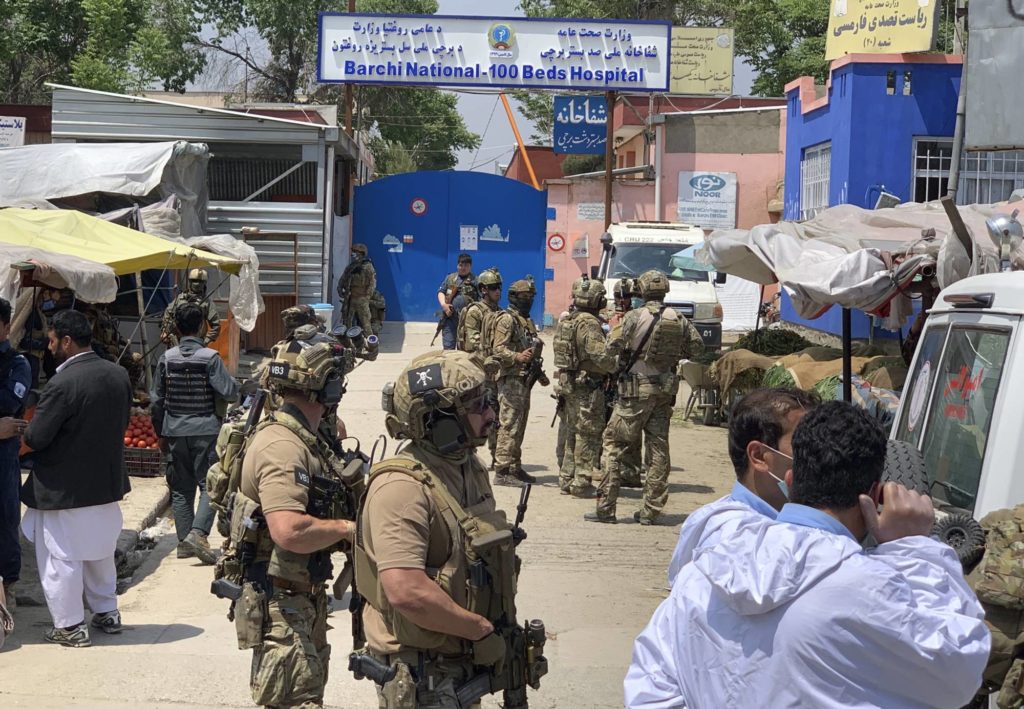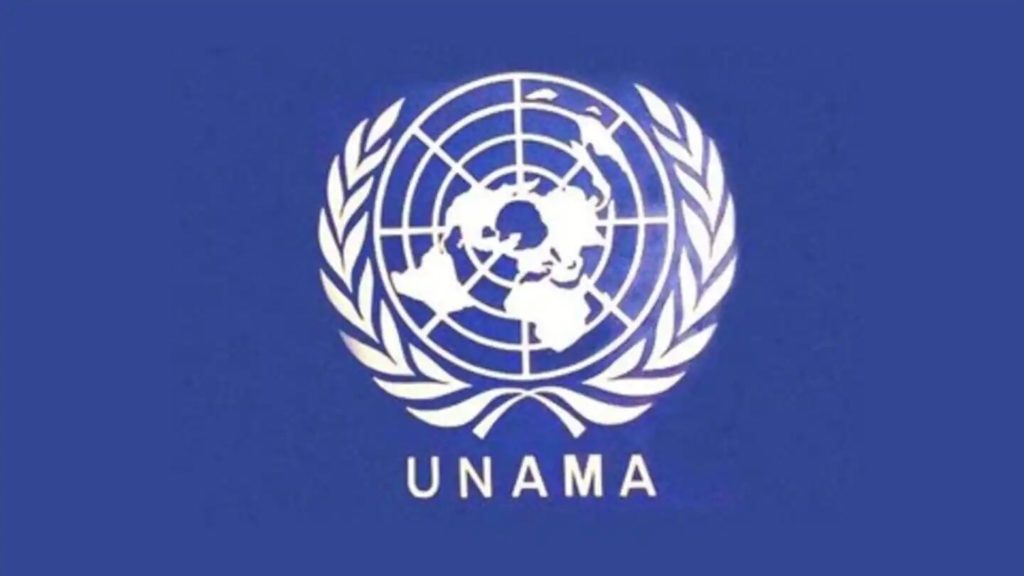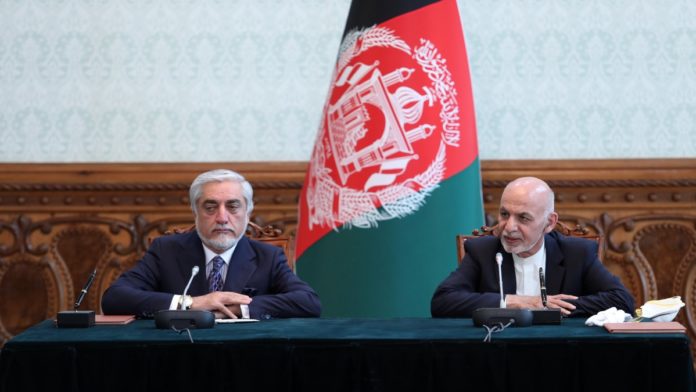The protracted election dispute which resulted in the bizarre reality of two men taking oath of office as President reached a resolution on May 17 when President Ashraf Ghani gave his chief rival, Abdullah Abdullah, the leading role in the country’s peace process with the Taliban and the right to appoint half the cabinet. Pakistan and the US have welcomed the development. With distraction removed the Afghan government may be able to move effectively to negotiate with the Taliban with whom the United States has signed an agreement for a gradual troop withdrawal from Afghanistan.
Two attacks in Afghanistan on May 11, attributed to Daesh, complicated the US push for peace. One attack on a Kabul hospital’s maternity ward killed 24 people, including two babies. Another at a funeral in Nangarhar in eastern Afghanistan killed 32. Following the attacks Afghan President Ashraf Ghani ordered the military to switch to “offensive mode” against the Taliban even though Taliban were not the attackers. This has bright to fore Ashraf Ghani-Abdullah-India nexus against Taliban.

In an interview with The Hindu, an Indian newspaper, US Special Representative for Afghanistan Zalmay Khalilzad said it would be “appropriate” for an India Taliban engagement. Responding to that statement, Pakistan’s Ambassador to the United States Asad Khan told Reuters on May 16, “It is for India to respond to that suggestion.” He said that India should speak with the Taliban if it feels that it will help the peace process. Khan said: “If India feels that their engagement is going to help the peace process, then we would defer to their judgment. But it’s not for us to sit in judgment on what they should do or they shouldn’t do.”
However, Taliban’s chief negotiator Abbas Stanikzai, in a recent interview criticized India’s role in Afghanistan and said New Delhi “had always supported traitors in Afghanistan”.
The Taliban have not carried out large attacks in Afghan cities since they signed the peace agreement. Under the agreement the Taliban promised not to target forces from the US-led coalition but made no such pledge toward Afghan troops.
Origin of some of such earlier attacks was traced back to Daesh’s India chapter. Such recent developments related to Afghanistan with Indian connections are noteworthy. For example an Indian launched a terrorist attack on a Sikh Gurdwara on March 25, 2020. The man speaking in Hindi in a heavy Malyalee accent, who later appeared on an ISIS or Daesh video was identified as Abu Khalid al-Hindi, who planted explosives in the Sikh prayer area before opening fire killing 50 Sikhs, Hindu and Afghan security personnel. According to reports in the media, Khalid-Al-Hindi is actually Muhammad Muhsin from Kasaragod, southern Indian state of Kerala.
Pakistan “strongly condemned the inhuman and cowardly terrorist attack on a medical facility in Kabul and the suicide attack on a funeral in Nangarhar province, resulting in the loss of so many precious lives. These terrorist acts are particularly despicable as they took place in the holy month of Ramzan and at a time when Afghanistan is grappling with Covid-19 pandemic”. A statement by the foreign office said.

The US has condemned the attacks in Afghanistan. In an unconscionable assault, gunmen seized one of Kabul’s busiest hospitals, which housed a maternity ward run by Doctors Without Borders. In the hospital, the terrorists took the lives of at least 13 innocent people, including newborn babies, new mothers, and health care workers. Any attack on innocents is unforgivable but to attack infants and women in labor in the sanctuary of a hospital is an act of sheer evil. Separately, in the eastern province of Nangarhar, a suicide bomber attacked the funeral of a local police commander, leaving at least 26 people dead and more than 68 wounded.
“In order to provide security for public places and to thwart attacks and threats from the Taliban and other terrorist groups, I am ordering Afghan security forces to switch from an active defence mode to an offensive one and to start their operations against the enemies,” President Ashraf Ghani said in a televised speech. This is against the US stance regarding lowering of violence by all warring factions to move ahead for implementing the February 29 Afghanistan Peace Agreement signed between the US and Taliban, concurrently the Afghan government had also signed a Memorandum of Understanding with the US for implementing the agreement. Though the Taliban denied responsibility for the bloodshed, Afghan officials appeared to connect the two attacks with rising Taliban violence in other parts of the country. “This is not peace, nor its beginnings,” Afghanistan’s national security adviser Hamdullah Mohib said in a post on Twitter. He said that the Taliban “subcontracted their terror to other entities” and that there is “little point in continuing to engage Taliban in ‘peace talks.’ ”
The US chief diplomat for Afghan peace, Ambassador Zalmay Khalilzad recently toured New Delhi, Doha and Islamabad to engage directly with officials in the respective capitals to review the ongoing efforts seeking a political end to the Afghan conflict. Khalilzad travels to Kabul and Islamabad frequently but of late he has added New Delhi in his travel schedules, raising questions about what prompted the US to reach out to India when it played little or no role in the Afghan peace process.
The US has reached out to India because it fears that New Delhi is creating impediments in the way of intra-Afghan talks. These sources believe India was behind President Ashraf Ghani’s reluctance to abide by the peace deal including the prisoners swap agreed in the US-Taliban deal. Delay in the prisoner exchange has put on hold the start of critical intra-Afghan talks, which were originally scheduled for March 10. Presumably, Khalilzad travelled to New Delhi with a brief, urging India not to create hurdles in the Afghan peace efforts.
Pakistan considers India as a spoiler, a view tacitly endorsed by the US when Washington kept New Delhi at bay while it was negotiating a peace deal with the Taliban. But Khalilzad in his recent visit to New Delhi wanted India to play a role and even suggested India to speak directly to the Afghan Taliban.
India is the main political ally of Ashraf Ghani after his controversial victory in the presidential elections. India fears that the peace deal in Afghanistan will erode its influence while Ghani also clearly sees his political demise if the US-Taliban agreement succeeds. This common cause has brought India and Ghani on the same page in opposing the deal with Taliban. Nonetheless, as of now, the US is keen to see this deal succeeding and hence is willing to make all out efforts.
Pakistan is not comfortable with the US outreach to India on Afghanistan. Pakistan feels that this is not the time for talking about Indian role but it was time to focus on implementation of the deal. “At the moment what is important [is] how to proceed ahead with the Afghan peace process. The role of India is a secondary issue,” said a Pakistani official Pakistan has long viewed Indian role in Afghanistan with suspicion and has presented irrefutable proofs of New Delhi using the Afghan soil to create trouble in Pakistan.
According to Kyle Rempfer’s report for Army Times, the US Army announced upcoming deployments for seven brigades on April 22. Of these, the 4th Infantry Division Combat Aviation Brigade stationed at Fort Carson Colorado will replace the 10th Mountain Division Combat Aviation Brigade as part of Operation Freedom Sentinel in Afghanistan. This is a clear departure from the earlier announcement that the US had stopped replacing the units whose tenure in Afghanistan was coming to an end.

The United Nations Assistance Mission in Afghanistan (UNAMA) reported on April 27 that violence surged in Afghanistan in the weeks after the United States and the Taliban signed a deal 0n February 29. The release of the UNAMA report comes hours after the US special envoy Zalmay Khalilzad called upon Taliban to implement a humanitarian ceasefire while Afghanistan tries to tackle its worsening coronavirus crisis. Taliban have launched their own campaign to help Afghanistan fight coronavirus. Afghanistan has detected more than 1,300 cases of the virus, but health experts say the number could be higher as testing is limited and Afghanistan’s weak healthcare system would have to struggle with a widespread outbreak. UNAMA has noted that pro-government forces were responsible for more than twice as many child deaths than Taliban during the first quarter mainly due to air strikes and shelling. “The report tracks a disturbing increase in violence during March at a time when it was hoped that the Government of Afghanistan and the Taliban would commence peace negotiations,” UNAMA said in a statement accompanying the release of its quarterly report.
More than 500 civilians were killed and over 700 injured during the first three months of the year, the UNAMA report said. While casualty numbers rose in March, UNAMA noted that the overall toll for the first quarter of 2020 was down 29 per cent from a year earlier, thanks to a lull in fighting in January and February. However, fighting spiked in March as the Afghan government and Taliban bickered over a number of issues, preventing negotiations between the two from opening. Recent attacks have mostly been limited to rural areas and small towns. Under the framework of US-Taliban deal, the insurgents have agreed not to attack cities. The Taliban have rejected the figures claiming the report “conceals the daily crimes” committed by the government and US forces.
UNAMA Chief Deborah Lyons said, “To safeguard the lives of countless civilians in Afghanistan and to give the nation hope of a better future, it is imperative that violence is stopped with the establishment of a ceasefire and for peace negotiations to commence. Afghans had enjoyed a period of relative calm in run up to the February 29 accord but the conflict resurfaced soon after the deal was signed and according to Aljazeera the Taliban have since rejected multiple calls for a ceasefire during the Islamic holy month of Ramazan. President Ashraf Ghani had also appealed to the group to lay down arms for the holy month.
The Taliban have cited continuing disagreements over the peace process and a delayed prisoner swap as reasons to keep fighting. Out of promised 5000, Afghan government released only 100 Taliban prisoners Taliban spokesman Suhail Shaheen said. A ceasefire would be possible if a potential peace process was being implemented “fully” but “hurdles” meant the Taliban would not yet lay down arms. “Asking for ceasefire is not rational and convincing.” wrote Shaheen. Citing disagreements over the peace process and a delayed prisoner exchange as reasons to keep fighting, the Taliban spokesman accused the Afghan government of putting prisoners’ lives at risk during the outbreak.
Under the deal, the Afghan government and the fighters were by now supposed to have concluded the prisoner swap and started talks aimed at bringing about a comprehensive ceasefire. The latest round of disputes came after dozens of Afghan security forces personnel were killed in a fresh wave of violence launched by the Taliban this week.
American and other occupation forces had pledged to leave Afghanistan by July 2021, provided the Taliban sticks to several security guarantees and holds talks with the government. “The current level of violence caused by the Taliban is not acceptable,” alliance ambassadors in NATO’s North Atlantic Council said in a statement on the peace efforts. Ghani had been calling for a lasting ceasefire with the Taliban for years, only to be ignored by the increasingly emboldened fighters. The Taliban instead has mocked Ghani’s government, referring to them as “puppets” controlled by foreign powers, and have roundly refused to engage in peace talks as it intensifies attacks on Afghan forces. The peace deal did not include a ceasefire, which has been left to the US backed government to negotiate with the insurgents.
Why are the Taliban reluctant to declare a ceasefire? It’s not only a negotiating tactic, there’s a real fear on the Taliban’s end about what happens after the guns go silent. The cessation of hostilities, however, seems to be a tricky subject with the Taliban leadership. Judging by their own statements and those of U.S. peace envoy Zalmay Khalilzad, one may assume that a complete ceasefire with the Afghan government, if it comes at all, lies at the far end of the road leading to the final peace agreement.
Daud Khattak in his August 13 piece “Why Are the Taliban Reluctant to Declare a Ceasefire?”, had summarized that :
“Taliban’s reluctance to declare a ceasefire, though, is understandable for several reasons. First, many Taliban militants did not return to join the fighting after the first ceasefire with the Afghan government over a year ago. That was the first time since the overthrow of Taliban regime that the militants freely mixed with their compatriots. They received hugs, posed for selfies, and some were even presented with flowers by common citizens in the streets of Kabul and other major cities. Fearing a repetition of the same experience, Taliban leaders will not come to a complete ceasefire until they get what they want from an expected peace deal. Second, the majority of the Taliban foot soldiers and their mid-ranking commanders have been brainwashed by ideologues. Over the years, they have been told they are performing a “sacred” duty by targeting Afghan security forces and Afghan officials. Applying the brakes to their “jihad” spree and ordering them to disarm may force many among the hardliners to defect to other groups, especially the Islamic State in Khorasan Province (ISKP), the Taliban’s main competitor and adversary in Afghanistan. Third announcing a ceasefire without getting their preferred deal may also send a signal of weakness to the Taliban adversaries not only on the battlefield such as the ISKP but also in the political sphere.
Besides being engaged in bloody fighting with the ISKP in recent past, the Taliban have a history of fighting with the then Northern Alliance as well as the Shia-Hazara community in the 1990s. The Taliban’s strength lies in their monopoly over violence be that targeting the Afghan security forces or civilians. A ceasefire will take away that monopoly and the advantage may shift to their ISKP adversary, a group whose agenda, unlike that of the Taliban, expands beyond the geographical borders of Afghanistan.
On a more basic level it is precisely the Taliban’s violence and callous attacks that forced the United States and the Afghan government to give them more concessions at the negotiating table. One major reason for the Taliban not announcing a ceasefire then is not to lose the position of strength. Once they disarm their soldiers the Taliban leadership will not draw more concessions at the negotiating table from their Afghan counterparts.
Fourth, a ceasefire may also cost the Taliban their foreign backing. Militarily, Taliban regional backers see the militia as a strategic partner to secure their interests in Afghanistan through their fighting power. Once the fighting is stopped, the Taliban will lose importance for their backers. Fifth and equally important is ensuring the continuous flow of funding for insurgent operations. The militia gathers huge sums of money from local taxation protection money from poppy farmers and drug dealers as well as transactions from their sympathizers abroad mostly Gulf countries to run their operations. Once the Taliban put an end to the so-called holy war by entering into a ceasefire agreement and hand over areas under their control to the Afghan government funds will cease to fill their coffers. None of the Taliban leadership is willing to let the huge sums of money go without being fully settled down in the seat of power in Kabul with maximum resources in their hands.
Sixth, over the years the Taliban knack for fighting and carrying out complex operations have humbled the Afghan security forces in the remote districts if not in the cities. The Taliban propaganda machine effectively highlights their victories albeit in the remotest parts of Afghanistan, over the ill-equipped and ill-trained Afghan forces to impress the common Afghans. The Taliban’s terror tactics have not only sapped the trust of common Afghans in the strength of their government and security forces but also affected the troops fighting capability. Calling a ceasefire from the Taliban perspective may provide breathing space that lets the Afghan government and its security forces review their strategies and regain their strength.
Finally, revenge-seeking is not uncommon in Afghan society, despite a genuine desire for lasting peace. The Taliban fear of revenge by the victims of their violence over the past 18 years is another factor keeping the militia’s leadership from accepting a permanent ceasefire.
Besides committing atrocities against the security forces and common Afghans, the Taliban also targeted powerful men and warlords during the past 18 years. Since the same people have gained strength, thanks to widespread corruption, since the Taliban’s removal from power, Taliban leaders may not escape revenge once their foot soldiers stop fighting. For skeptical observers, the Taliban’s unwillingness to call a ceasefire is a trick to strengthen their grip over power once the US forces withdraw from Afghanistan. But a different look may also reveal the fear factor that keeps the militia’s leadership from disengaging their fighters. More efforts with trust building may help achieve lasting peace in the post-withdrawal Afghanistan”.
For lasting peace in Afghanistan, the US will have to, sooner or later, put its foot down to force India to wind up its terror shop in Afghanistan. Otherwise various actors will continue to move in circles to sustain violence oriented status quo. The US cannot go on appeasing India and expect reduction of violence in Afghanistan.





